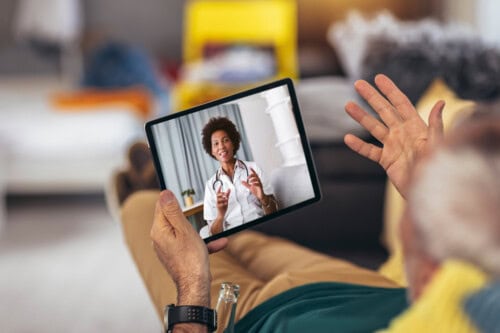As telehealth for diabetes becomes more common for the management of chronic conditions, Nurse Practitioners need to know how to discuss diabetes treatment goals and monitoring options with patients. In this article, we will go over common diabetes management medications and the best practices for monitoring diabetes management in a telehealth setting.
Related: Online Course: Rx Essentials: Type 2 Diabetes Prescribing Update
What are the most common medications for diabetes management?
There are two types of medications for diabetes management. First, insulin-sensitizing medications help the body more efficiently use the insulin the body produces. Second, insulin-releasing medications are for patients who no longer produce insulin at all.
What are insulin-sensitizing medications?
In terms of insulin-sensitizing medications, Metformin and Pioglitazone are the two most common. Both can be expected to decrease A1C levels by 1-2%. Additionally, because they do not release insulin or affect insulin release at all, there is no meaningful risk of hypoglycemia with these medications.
Metformin is typically the first-line drug for diabetes management. It should be continued as long as tolerated and not contraindicated. Metformin may be contraindicated in certain circumstances due to the rare risk of lactic acidosis. This would be in the presence of impaired renal function, heart failure, and adults aged 75 or older.
The second common insulin-sensitizing medication is Pioglitazone (Actos). This medication has a different mechanism than Metformin, meaning it is possible to use the two together. However, there is a risk of edema, particularly with insulin use, and a risk that it could cause or exacerbate heart failure.
What are insulin-releasing medications?
There are many insulin-releasing medications on the market for diabetes management. However, their mechanisms differ, as do their risks and benefits. For example, sulfonylurea (SU) medications – such as glipizide, glyburide, and glimepiride – work by increasing insulin release. This is constant regardless of blood glucose level, which means that it comes with a high risk of hypoglycemia, especially in older adults with irregular eating patterns or people with impaired renal function.
Incretin-based therapies, on the other hand, such as DPP-4 inhibitors and GLP-1 agonists, influence insulin release post-ingestion of carbohydrates. This helps regulate blood glucose levels by preventing postprandial elevation. Nurse Practitioners should work with patients to understand these risks and evaluate which medications are right for them.
What are medication prescribing considerations for diabetes management?
There are several important considerations a Nurse Practitioner should discuss with a patient to ensure their diabetes management goals are met. Some of the main diabetes prescribing considerations include cost, established cardiovascular disease, hypoglycemia risk, impact on weight, and role in beta cell preservation.
Related: RX Essentials | Diabetes Update: Focus on the Latest Recommendations
What are the targets for glycemic control?
One of the most important things for Nurse Practitioners to discuss with patients is their glucose range. When fasting, glucose levels should be below 100 mg/dL, and the ADA goal is between 80-130 mg/dL. At peak postprandial, or 1 to 2 hours after eating, glucose levels should remain under 140 mg/dL and ADA levels under 180 mg/dL.
However, these targets may need to be altered based on the person. It is not uncommon for younger people to have fasting glucose levels in the 70s or 80s. Therefore, depending on the person, a fasting glucose close to 100 may be an early sign of insulin resistance.
What does “time in range” mean in diabetes management?
As continuous glucose monitoring is becoming much easier and more affordable, it is easier for patients with diabetes to monitor their time in range. Time in range is a measure of how much time the patient spends within the target glucose range. Time in range is a key metric for long-term diabetes management because it helps patients avoid hyperglycemia and diabetes-related organ damage. Nurse Practitioners can educate patients about the benefits of continuous glucose monitoring and how their lifestyle can help ensure maximum time in range.
What are the ABCs of diabetes management?
A series of letters – ABCDEFGH – can help Nurse Practitioners remember to check all the important boxes of diabetes management. These include medication suggestions and lifestyle considerations to help patients with Type II diabetes stay healthier.
- Aspirin: Patients with diabetes should be considered candidates for regular aspirin therapy if they have at least one cardiovascular disease risk. For men over 50 and women over 60, 75-162 mg is an effective dose.
- Blood pressure: For patients with high blood pressure, Nurse Practitioners should prescribe a combination therapy of 2 or more agents per ADA recommendations, remembering to avoid orthostatic hypotension risk in older adults with diabetes.
- Cholesterol: Patients with diabetes and dyslipidemia may be treated with moderate to high-intensity statin therapy. It is also important for all patients to have their lipid profile checked annually.
- Creatinine: Patients with diabetes need to have serum creatinine and urine microalbumin levels checked annually.
- Diet: Patients with diabetes should limit their intake of trans and saturated fats. In many cases, it is appropriate for a Nurse Practitioner to refer patients to a medical nutritional therapy with a registered dietician.
- Dental care: Nurse Practitioners should counsel patients with diabetes to seek regular dental care. Dental decay and periodontal disease worsen insulin resistance, so patients must take their dental health seriously.
- Vitamin D: There is a suggested link between Vitamin D deficiency and an inability to maintain appropriate glucose levels. Therefore, patients with diabetes may benefit from a minimum supplementation of 600 units daily.
- Exercise: Patients with diabetes should try to get at least 150 minutes per week of moderate activity 4 times per week. One important thing Nurse Practitioners should ensure patients understand is the importance of avoiding 48 hours without exercise. Because physical activity has an insulin-sensitizing effect that drops significantly after 48 hours, going without physical activity can be dangerous for diabetes patients.
- Eye exam: Patients with diabetes should receive a dilated eye exam annually for retinopathy or other eye problems.
- Foot exam: Every time a Nurse Practitioner sees a patient with diabetes, it is important to conduct a foot exam. A comprehensive lower extremity sensory exam should be conducted annually. During a telehealth for diabetes visit, Nurse Practitioners can remind patients of protective foot behavior.
- Goals: Nurse Practitioners engaging in telehealth for diabetes need to review overall goals with patients periodically. They may forget which of their medications do what, and in turn, be less compliant if they don’t know why they are taking it.
- Hypoglycemia: Finally, let’s discuss one of the most important risks of diabetes management: hypoglycemia.
What are the signs of hypoglycemia?
One major part of remote diabetes management is educating patients on hypoglycemia. Hypoglycemia is a low blood glucose level at which an individual becomes symptomatic, typically occurring at less than 50 mg/dL. If not treated, hypoglycemia can lead to a diabetic coma and even death. Therefore, when considering telehealth for diabetes care, it is important for Nurse Practitioners to explain hypoglycemia risk factors and symptoms to patients.
The sympathoadrenal symptoms of hypoglycemia include sweating, tremor, tachycardia, hunger, and anxiety. Additionally, the neuroglycopenic symptoms of hypoglycemia include weakness, tiredness, dizziness, inappropriate behavior, confusion, and blurred vision.
Because of these symptoms, especially confusion, a patient displaying signs of hypoglycemia may not recognize their condition. For this reason, Nurse Practitioners should ensure family members are also aware of these symptoms and how to treat hypoglycemia.
What are the risk factors of hypoglycemia?
Nurse Practitioners must discuss the risk factors of hypoglycemia with patients. Long-term diabetes management necessarily involves several lifestyle guidelines that can be hard to adhere to. Patients will be more compliant if they understand the importance of these guidelines.
Some of the common risk factors of hypoglycemia include meal skipping, increasing exercise or physical activity without adjusting medication, an excessive dose of medication, and drinking alcohol, due to the sugar content of alcohol. Nurse Practitioners should remember that due to poor regular appetites, older adults with diabetes are more susceptible to meal skipping. This puts them at higher risk for hypoglycemia. During a telehealth for diabetes visit, Nurse Practitioners can discuss the patient’s meal schedule, physical activity levels, and drinking habits to help patients mitigate these risk factors.
What is the best way to treat a hypoglycemic episode?
If a patient is experiencing a hypoglycemic episode, they will likely not be able to give themselves the care they need to recover. For this reason, Nurse Practitioners should counsel family members on the appropriate protocol. The best way to treat a hypoglycemic episode is using the 15/15 Rule. This stands for 15 grams of a simple carb or glucose and then 15 minutes of waiting.
Nurse Practitioners can help patients and their loved ones create a plan for a hypoglycemic episode, including suggesting the proper items and good storage locations. Glucose tubes are effective treatment items because they come dosed properly in 15-gram sizes. Raisins, candy, and soda or juice are also good options, as they have simple sugars that will be digested most quickly. Helping patients prepare for a hypoglycemic episode is an important part of diabetes management care.
Want to learn more about telehealth for diabetes? Earn CE hours with our online course on Rx Essentials: Type 2 Diabetes Prescribing Update (free with Passport Membership)!





